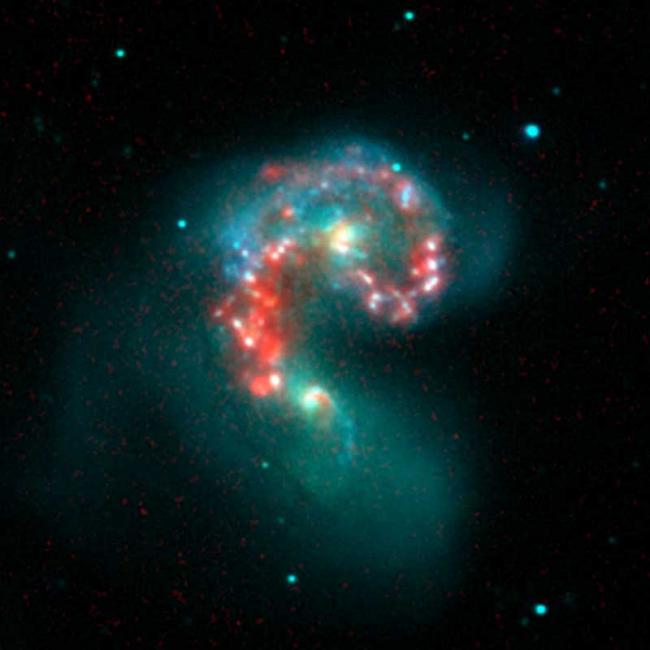
An infrared image of the Antennae Galaxy, a pair of relatively nearby colliding galaxies with regions emitting brightly from the carbon-rich grains called polyaromatic hydrocarbons (PAHs; seen here in red). Astronomers have detected luminous galaxies emitting from PAHs at an epoch when the universe was only about 3 billion years.
DOGs ("Dust-Obscured Galaxies") are a newly discovered type of galaxy that is extremely luminous but also particularly heavily obscured by dust. Astronomers wonder if they might be a subclass of the group of ultraluminous infrared galaxies (ULIRGs), galaxies that shine with the luminosity of a hundred (or more) Milky Way galaxies but that are largely invisible because their tremendous energy output falls mostly at infrared wavelengths, produced by warm dust. What heats the dust in ULIRGs and DOGs is the subject of intensive research, but in ULIRGS it appears to be bursts of star formation; other luminous galaxies are powered by supermassive black holes that form at their nuclei. If scientists could identify the power source in DOGs they could examine if and how these mysterious new objects are related to other galaxies.
ULIRGs are thought to result from collisions between galaxies; the collisions act to stimulate the star formation. Since collisions are common, they could represent a period of stellar growth and enrichment that many galaxies (perhaps even our own galaxy) briefly experience. Star formation is characterized by emission from small, carbon-rich grains called polyaromatic hydrocarbons, or PAHs -- grains with 60 or more carbon atoms (plus other attached atoms). Scientists recently reported finding the first evidence for these grains in distant radio galaxies, a clear indication that ancestral galaxies also were busy making new stars.
In a new research paper, CfA astronomers Mark Brodwin, Matthew Ashby, Jiasheng Huang, Howard Smith, and Steve Willner, together with a team of thirteen other astronomers, describe their discovery of PAH emission from distant DOGs. The team used the Spitzer Space Telescope to study the light from luminous galaxies that were active when the universe was only about three billion years old. From a sample of DOGs discovered in these Spitzer infrared images, they selected twenty-three that seemed a little bit fainter and a little bit redder than the others. Spectra of these objects disclosed PAH emission: a clear indication that these objects are indeed powered by star formation, even in the young universe. (The brighter, bluer DOGs on the other hand show evidence of being energized by a black hole nucleus.) If all the luminosity in these DOGs comes from new stars, the rate of forming them would be fantastic -- perhaps as much as 1000 times the present rate in our Milky Way. This number is so large that it suggests that the way of estimating the rate of star formation in the early universe may be quite different than the methods used to estimate it today. The results help to better understand this new category of galaxy, the conditions needed to make stars, and the environment in the universe when it was only three billion years old.